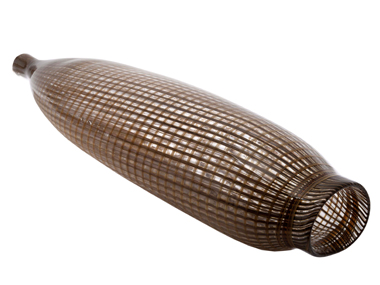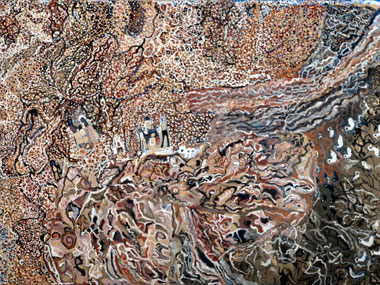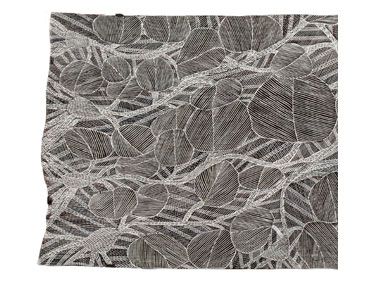NATSIAAS REFRESHED

Big Telstra winner, Jenni Kemarre Martiniello (Arrernte Language, Kemarre Moiety, Canberra Residence) 'Golden Brown Reeds Fish Trap', hot blown glass, canes
Aboriginal Art Directory | 09.08.13
News source: From Jeremy Eccles in Darwin
The leaders of both of the main groupings of remote Aboriginal art centres have spoken out recently about the gulf between Indigenous and urban Australia. Philip Watkins, CEO of Desart, representing 45 Central Australian centres, rationalised that “High end galleries specialising in Indigenous art may be on their knees, but the shared dream of a thriving, sustainable Aboriginal art sector survives”. Further north, Christina Davidson of ANKAAA, with as many art centre members in The Kimberley and Arnhemland observed, “There are amazing custodians of traditional knowledge who are alive and well in the very contemporary world; but it feels as though mainstream Australia and remote, traditional Australia are inhabiting completely different universes”.
Perhaps today’s opening of the 30th annual National Aboriginal & Torres Strait Islander Art Awards (the NATSIAAs) at the Museum & Art Gallery of the NT in Darwin will help to close that cultural gap. For it was announced that MAGNT’s Telstra Collection – built up since Telstra started sponsoring the Awards 22 years ago – will soon be appearing electronically on the Google Art Project. It could be said to have the effect of making MAGNT the virtual national Indigenous art gallery.
And this sense of contemporaneity is also reflected in the 2013 Award-winners. Canberra’s Jenni Kemarre Martiniello won the Big Telstra (of $40,000) for a magnificent metre-long glass-work reflecting the woven fish traps that were made by her Arrernte forebears in the desert. It took the assistance of seven colleagues at the Canberra Glassworks to achieve. “But that’s appropriate”, said Martiniello, who’s only been working in glass since 2008, after a career in sculpture and textiles; “we’ve always been collaborative in Aboriginal society”.
Mavis Ngallametta’s vibrant Cape York landscape was more traditional as the Telstra General Painting winner. “It really drew me in”, explained one of the three judges – Bruce McLean the QAG’s Indigenous curator. “There’s so much rhythm and movement on that canvas. Her strange logic marrying abstraction with some figuration just spoke to me. But it also raised pre-selection problems. On a computer screen, the scale was impossible to appreciate and, frankly, the texture looked quite muddy - the detail was missing. I don’t know how we get round this – it would be impossible for all 240 entrants to send stretched and framed works”.
Interestingly a total innovation in the vibrant Darwin art scene this week is a Salon des Refuses – where artists and art centres were so keen to be seen that they did provide the joint efforts of the Outstation and Paul Johnstone Galleries owners with fully hangable artworks. 40 of them. And that raised fascinating questions for me. Why would anyone want to admit their ‘failure’ at the NATSIAAs? For, of course, the staff at MAGNT didn’t announce the names of the 163 that failed to make the cut – only the 77 that succeeded. But it appears that, in parlous times, art people are prepared to take any chance of an appearance in Darwin at this rich cultural time – and of a sale. And of course, in the light of McLean’s comments, a digital rejection might have been a flawed judgment.
In the light of this, I’d argue that both Kathy Maringka’s and Ngupulya Pumani’s heavily dotted works could well have looked richer in the flesh than on screen (Rarrk can likewise look quite shadowy). I’d also question the NATSIAA refusal (we don’t like the word rejection!) of Irene Namok, Lisa Uhl and Ruby Williamson. But they surely justified refusal for several other works that were over-neat, over-familiar, or just not as good as we know an artist can be. Sadly, last year’s Big Telstra winner Timothy Cook fell into both of the last two categories.
The chance of a sale is probably greatest at the Darwin Aboriginal Art Fair. DAAF is now in its 7th year, and seems to have overcome all the reticence that characterised its early years – cramped spaces, changing venues and messy stalls. In the shiny Convention Centre, Claire Summers has laid things out generously, with room to meet, talk and drink coffee in the middle. 44 art centres from as far away as Erub in the Torres Strait and Albany in WA have made the journey; strange and wonderful names like Kulumindini Arts (for the women of the Barkly) and Mardbalk Arts (from S Goulburne Island) were new to me. And I noted with pleasure a gorgeous Sun Mat from Gapuwiyak, a delicious Tom Lewis print from Djilpin and a painted melange of seaweed from Kira Kiro in remotest Kalumburu.
It’s very easy to get distracted from the NATSIAAs as you can see! Which is a shame, because I felt a real sense of refreshment there. With filmed work coming from both Torres Strait artists and the Sydney-based Nicole Foreshaw – could this be the first Indigenous performance piece; with fresh names like her, Terrence Wright, Beryl Jimmy, Caroline Oakley, Leah Umbagai and Kemei Tabo popping up from all over the country; with four portraits – including one that Will Stubbs insists is the first ever Yolngu portrait - reflecting a surprising new trend in Indigenous art; and with a engaging new shape to the gallery from new curator Allison Thatcher, the 30th NATSIAAs definitely feel “thriving and sustainable”.
You may have noted a number of non-tribal names there. I reckon that urban NSW has never had three finalists before. And the team of Foreshaw, Wright (with glass didgeridoos) and Oakley with a major cut, paste and drawn portrait did the State proud. Significantly absent (and unmissed) was urban Queensland.
But New Media Award-winner Raymond Zada from SA brought some of its political zip to the party. Last year’s Works on Paper winner for his word-play in a computer-generated ‘Racebook’, has not sat on his laurels but grown in confidence. This time he’s transmitting big words on to a black wall under the simple title, ‘Sorry’. But it’s quite complex – as Zada explains: “ aul Keating’s famous Redfern speech recognised the mistreatment of Aboriginals and Torres Strait Islanders, but made no apology Kevin Rudd’s moving Parliamentary speech apologised for the laws and policies of successive parliaments and governments, but not for all the subsequent actions. Sorry merges the speeches by combining the apology with the actions”. So easy!
It would be a strange year without a winner from the Buku Larrngay Art Centre at Yirrkala – especially in this 50th anniversary of their pioneering Bark Petition – celebrated at the Art Fair. And their grip on the Bark Painting Award was unreleased as Malaluba Gumana delighted with a black and white bark featuring a profusion of water-lillies. Also referenced was Witij, the olive python Rainbow Serpent in megafauna form, over 12 metres long, and the power of the cyclone to flatten trees and revitalise the land beneath. “Is this the oldest story known to human kind – here in a contemporary flowering?”, demanded an ebullient Will Stubbs.
The final winners were Cape York’s Teho Ropeyarn – presciently selected for the MCA’s Primavera show in Sydney last year – for Works on Paper, and Rhonda Sharpe reflecting life in the Alice Springs Town Camps through her soft-sculptured aliens, winning the 3D Award. Ropeyarn’s work is Cape York going on Torres Strait, with a really strong clan and totemic identity wrapped up in a very contemporary print form. Sharpe was Commended last year and has simply gone on weaving together the oppressive past of mission blankets with a stressful present of Town Camp life, in ever more fanciful forms. Her aliens “Came from Nowhere” – could that be a colonialist European country?
So, what message do I draw from this 30th NATSIAA? People won’t get in on past reputation. A delicate Ampilatwatja classic and a blinding Spinifex Men’s work were fully justified; a shortage of Papunya Tula’s predictability was also justified. Film, glass, woven metal, ghost net remnants and ceramics (such as Derek Thompson’s grand vase) justifiably pushed traditional boundaries. While the elegant Regina Wilson returned to her weaving origins with aplomb.
How much is simply a reflection of what’s happening out there, and how much should be down to the judges? Well, the judges this year were MAGNT Director Pierre Arpin, QAG curator Bruce McLean and Melbourne multi-media artist Destiny Deacon. Overall, I got the impression that there was strong curatorial push to “make a good show for the punters” in the fine words of the irrepressible Destiny Deacon. Others might argue that this isn’t what a competition should be about. But they won’t get much change out of Pierre Arpin. He is insistent that it’s his responsibility as the first MAGNT Director ever to have put himself forward as a judge to “shape the space and intrude the institutional voice”.
He may well be back doing that again next year – especially if his hopes come to fruition that the NT Government separates the Museum off from the rest of its apparatus with a statutory board that has genuine powers and responsibilities – under current chair Alan Myers QC.
Share this:
»  del.icio.us
»
del.icio.us
»  Digg it
»
Digg it
»  reddit
»
reddit
»  Google
»
Google
»  StumbleUpon
»
StumbleUpon
»  Technorati
»
Technorati
»  Facebook
Facebook
Contact Details
Gallery: Museum and Art Gallery of the Northern Territory
Contact: Marcus Schutenko
Email: info@magnt.net.au
Telephone: +61 8 8999 8264
Address: 19 Conacher Street Fanny Bay 0820 NT

General Painting winner, Mavis Ngallametta (Kugu Uwanh Language, Putch Clan, Aurukun Residence) 'Yalgamunken #3' ochre and charcoal and acrylic on linen

Bark Painting winner, Malaluba Gumana (Miwatj Language, Dhalwangu Clan, Nungburundi Subsection, Yirritja Moiety, Gangan Residence) 'Dhatam' orche on bark
Further Research
Artists: Jenni Kemarre Martiniello | Malaluba Gumana | Mavis Ngallametta
News Tags: Alan Myers QC | Bruce McLean | Christina Davidson | Darwin Art Fair 2013 | Destiny Deacon | Jenni Kemarre Martiniello | Jeremy Eccles | Kevin Rudd | MAGNT | Malaluba Gumana | Mavis Ngallametta | NATSIAAs | Paul Keating | Philip Watkins | Pierre Arpin
News Archive
- 28.04.21 | CANBERRA
- 23.04.21 | Sydney Biennale - 'From a Brook to a River'
- 22.04.21 | 2021 Telstra NATSIAA Finalists Announced
- 15.04.21 | National Aboriginal Art Gallery Gets a Boss
- 29.03.21 | THE NATIONAL 2021
- 26.03.21 | TRUTH-TELLING
- 24.03.21 | All Revealed in Freo
- 22.03.21 | Bla Mela Kantri
- 19.03.21 | Two Big Moves
- 16.03.21 | The Very Late Charlie Flannigan
- 08.03.21 | PAPUNYA ART AT 50
- 05.03.21 | ANTEDILUVIAN ROO
- 19.02.21 | National Endowment for Indigenous Visual Arts
- 19.02.21 | lutruwita apology
- 17.02.21 | SONGSPIRALS TWIST AROUND SONGLINES
Advertising

